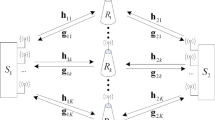Abstract
We consider a cellular two-way relaying system in which a multi-antenna base station (BS) communicates bidirectionally with one of several single-antenna mobile stations (MSs) via a single-antenna relay using analog network coding. We employ MS selection coupled with beamforming at the BS so as to maximize the end-to-end signal-to-noise ratios. In the considered system, the target rates at the sources can generally be different owing to the asymmetric traffic flow in opposite directions. With such a general setup, we perform an overall system outage probability analysis over Rayleigh fading channels. For more insights, we derive a closed-form asymptotic expression for overall outage probability and an upper bound expression for ergodic sum-rate of the system. Based on these expressions, we show that the system achieves a performance gain, and a diversity order of minimum of the number of BS antennas and the number of MSs. Moreover, we address the problem of optimization of relay location in order to minimize the overall system outage under asymmetric traffic conditions. Finally, we provide numerical and simulation results to corroborate the theoretical analysis and the advantages offered by the proposed scheme.





Similar content being viewed by others
References
Peters, S. W., Panah, A. Y., Truong, K. T., & Heath, R. W. Jr. (2009). Relaying architectures for 3GPP LTE-advanced. EURASIP Journal on Wireless Communications and Networking, article ID 618787.
Sendonaris, A., Erkip, E., & Aazhang, B. (2003). User cooperation diversity—Part I: System description. IEEE Transactions on Communications, 51(11), 1927–1938.
Laneman, J. N., Tse, D. N. C., & Wornell, G. W. (2004). Cooperative diversity in wireless networks: Efficient protocols and outage behavior. IEEE Transactions on Information Theory, 50(12), 3062–3080.
Ahlswede, R., Cai, N., Li, S. Y. R., & Yeung, R. W. (2000). Network information flow. IEEE Transactions on Information Theory, 46(4), 1204–1216.
Wu, Y., Chou, P., & Kung, S. Y. (2005). Information exchange in wireless networks with network coding and physical-layer broadcast. In Proceedings of 39th annual conference on information science and systems.
Larsson, P., Johansson, N., & Sunell, K. E. (2006). Coded bidirectional relaying. In Proceedings of IEEE vehicular technology conference (pp. 851–855).
Popovski, P., & Yomo, H. (2006) Bi-directional amplification of throughput in a wireless multihop network. In Proceedings of IEEE vehicular technology conference (pp. 588–593).
Zhang, S., Liew, S. C., & Lam, P. P. (2006). Physical-layer network coding. In Proceedings of ACM MobiCom (pp. 358–365).
Kim, S. J., Mitran, P., & Tarokh, V. (2008). Performance bounds for bi-directional coded cooperation protocols. IEEE Transactions on Information Theory, 54(11), 5235–5241.
Rankov, B., & Wittneben, A. (2007). Spectral efficient protocols for half-duplex relay channels. IEEE Journal of Selected Areas in Communications, 25(2), 379–389.
Katti, S., Gollakota, S., & Katabi D (2007). Embracing wireless interference: Analog network coding. In Proceedings of ACM SIGCOMM (pp. 397–408).
Popovski, P., & Yomo, H. (2007). Wireless network coding by amplify-and-forward for bi-directional traffic flows. IEEE Communications Letters, 11(1), 16–18.
Upadhyay, P. K., & Prakriya, S. (2011). Performance of two-way opportunistic relaying with analog network coding over Nakagami-m fading. IEEE Transactions on Vehicular Technology, 60(4), 1965–1971.
Upadhyay, P. K., & Prakriya, S. (2011). Performance of analog network coding with asymmetric traffic requirements. IEEE Communications Letters, 15(6), 647–649.
Viswanath, P., Tse, D. N. C., & Laroia, R. (2002). Opportunistic beamforming using dumb antennas. IEEE Transactions on Information Theory, 48(6), 1277–1294.
Jang, Y. U., & Lee, Y. H. (2010). Performance analysis of user selection for multiuser two-way amplify-and-forward relay. IEEE Communications Letters, 14(11), 1086–1088.
Upadhyay, P. K., & Prakriya, S. (2011). Outage analysis of user scheduling with antenna selection in multiuser two-way AF relaying. In Proceedings of international conference on devices and communications.
Larsson, E. G., & Stoica, P. (2003). Space-time block coding for wireless communications. Cambridge: Cambridge University Press.
Bletsas, A., Khisti, A., Reed, D. P., & Lippman, A. (2006). A simple cooperative diversity method based on network path selection. IEEE Journal of Selected Areas in Communications, 24(3), 659–672.
Alouini, M. S., & Goldsmith, A. J. (1999). Capacity of Rayleigh fading channels under different adaptive transmission and diversity-combining techniques. IEEE Transactions on Vehicular Technology, 48(4), 1165–1181.
Gradshteyn, I. S., & Ryzhik, I. M. (2000). Tables of integrals, series and products (6th ed.). New York: Academic Press.
Abramowitz, M., & Stegun, I. A. (1972). Handbook of mathematical functions with formulas, graphs, and mathematical tables (10th ed.). New York: Dover.
Boyd, S., & Vandenberghe, L. (2004). Convex optimization. Cambridge: Cambridge University Press.
Author information
Authors and Affiliations
Corresponding author
Rights and permissions
About this article
Cite this article
Upadhyay, P.K., Yadav, S. On the Performance of Cellular Two-Way Relay Systems with Analog Network Coding and Multiuser Diversity. Wireless Pers Commun 72, 2705–2720 (2013). https://doi.org/10.1007/s11277-013-1175-z
Published:
Issue Date:
DOI: https://doi.org/10.1007/s11277-013-1175-z




